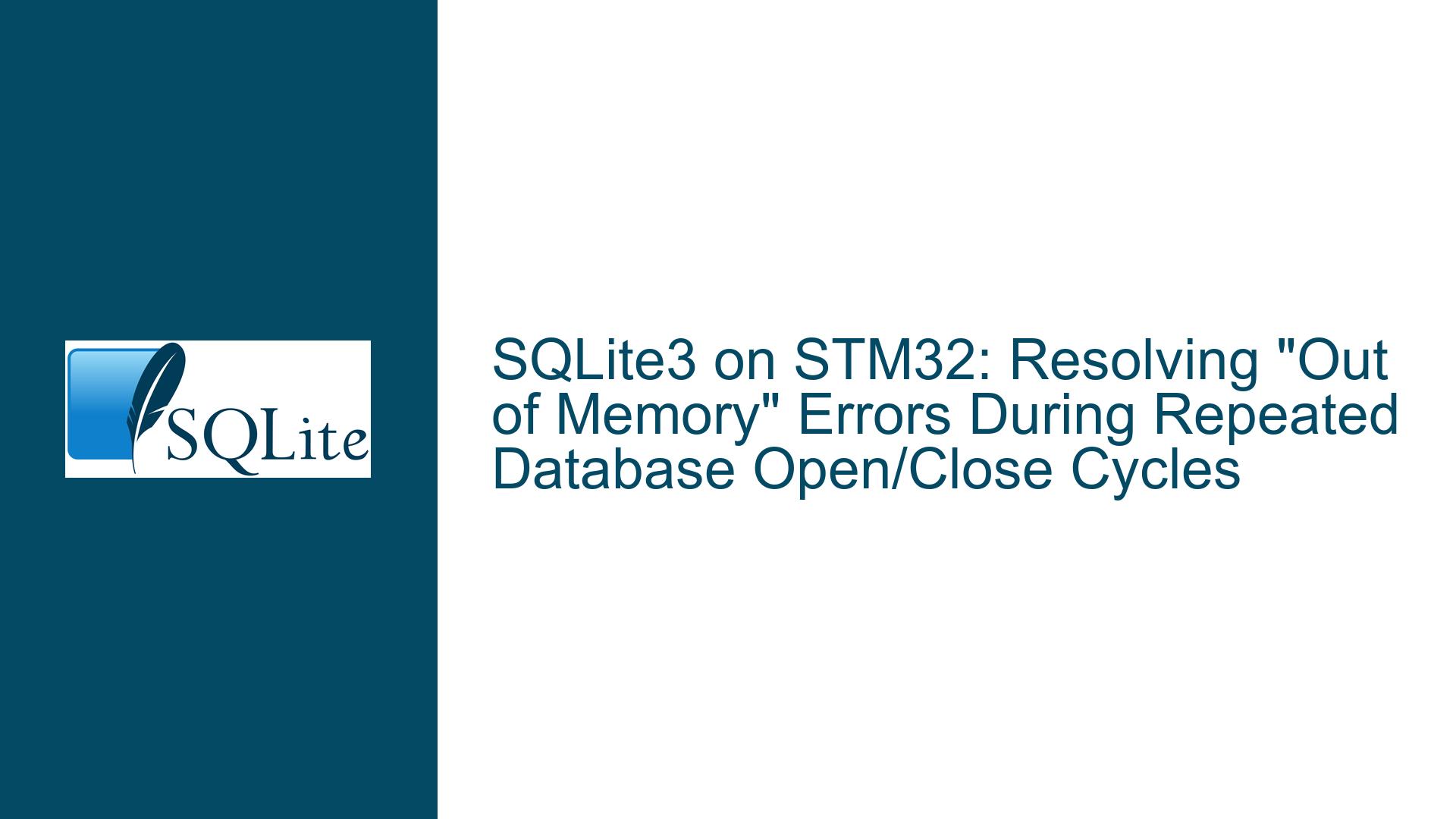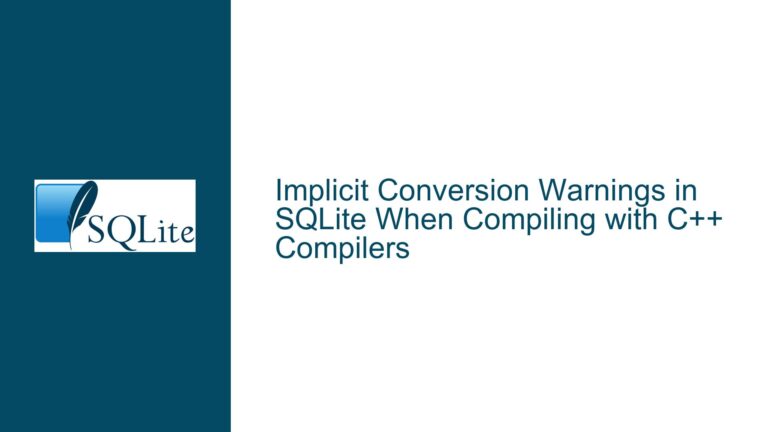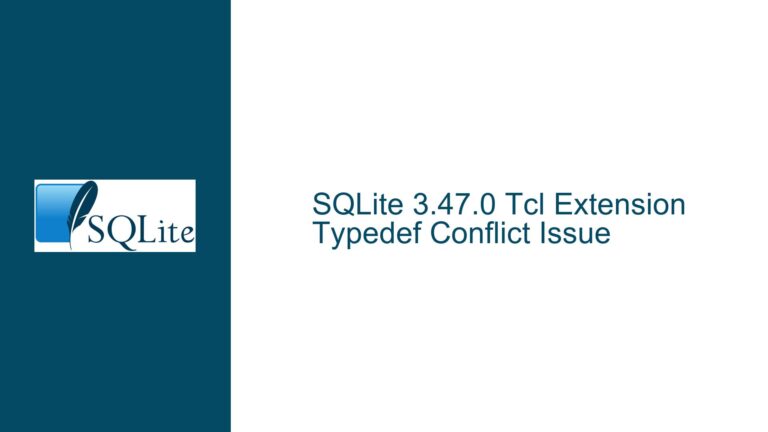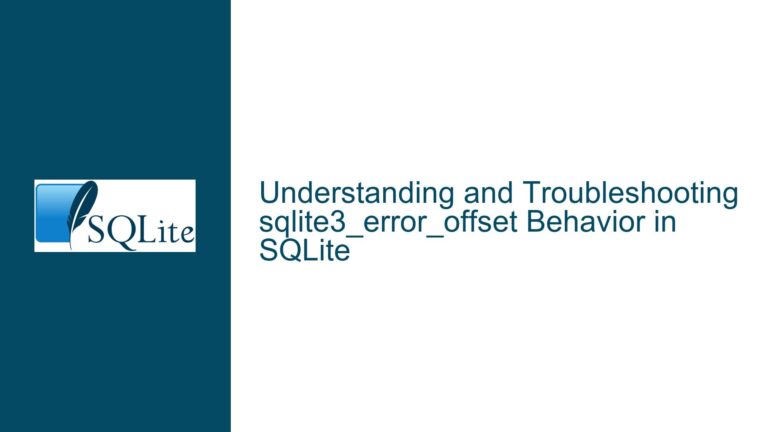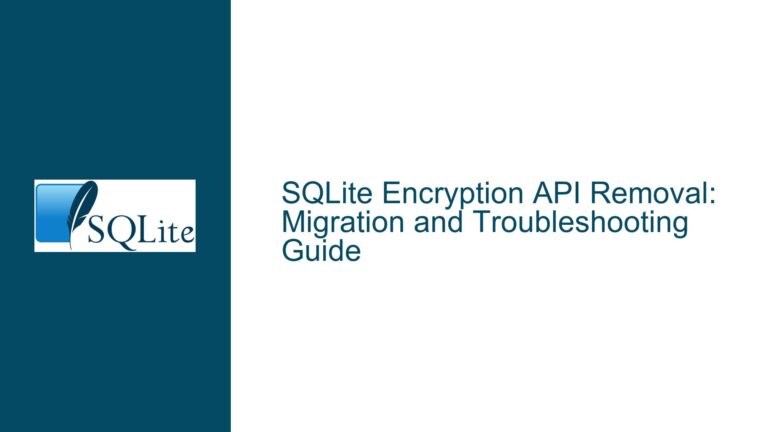SQLite3 on STM32: Resolving “Out of Memory” Errors During Repeated Database Open/Close Cycles
Database Connection Lifecycle Management in Embedded SQLite Implementations
The core challenge in this scenario revolves around managing SQLite database connections and global resource allocation in embedded systems with constrained memory environments. When working with SQLite3 on resource-limited platforms like the STM32H7 microcontroller, improper handling of database lifecycle operations (open/close) and global SQLite configuration states can lead to memory leaks, resource exhaustion, and unexpected pointer behavior. The specific manifestation of SQLITE_NOMEM (error code 7) during subsequent database opening attempts indicates fundamental issues in memory management and SQLite instance termination routines.
Critical Analysis of Connection Closure Mechanics
The root cause of the observed "Out of memory" errors stems from three primary factors interacting with the SQLite library’s internal state management:
1. Premature Global Shutdown Sequence
The original implementation called both sqlite3_shutdown() and sqlite3_os_end() during every database closure. These functions perform global library deinitialization, including:
- Releasing all memory pools
- Resetting internal mutex systems
- Unregistering virtual filesystem (VFS) implementations
- Clearing prepared statement caches
Repeatedly invoking these global cleanup functions between database operations creates an inconsistent library state where subsequent sqlite3_open() calls attempt to initialize against a partially deinitialized environment. The memory allocator becomes particularly vulnerable as SQLITE_CONFIG_HEAP configurations may be cleared while the application still holds active pointers.
2. Bitwise Error Accumulation
The use of |= operator for error code handling creates cumulative failure states:
rc |= sqlite3_close(db);
rc |= sqlite3_shutdown();
rc |= sqlite3_os_end();
This approach masks individual operation failures and forces continuation of destructive cleanup processes even when initial operations (like sqlite3_close()) report errors. If sqlite3_close() returns SQLITE_BUSY (5), the subsequent shutdown calls would still execute, compounding the error state.
3. Memory Fragmentation in Custom Allocators
The STM32H7’s hybrid memory architecture (internal SRAM + external FRAM) introduces complex memory management requirements. When using SQLITE_CONFIG_HEAP with custom memory allocators:
sqlite3_config(SQLITE_CONFIG_HEAP, custom_heap_ptr, heap_size, min_alloc_size);
Improper alignment between SQLite’s memory chunk sizing and the FRAM/SD card controller’s buffer requirements can create persistent memory fragmentation. Each database open operation allocates:
- 40KB for page cache (default)
- VFS structure (256+ bytes)
- Database connection object (1.5KB+)
- Transaction journal buffers
If these allocations aren’t properly released and coalesced during closure, subsequent open attempts may fail due to apparent memory exhaustion, even when sufficient physical memory exists.
Comprehensive Solution Strategy for Robust Connection Cycling
Phase 1: Proper Database Closure Sequence
Revise the database closure routine to follow SQLite’s recommended cleanup sequence:
int ju_sqlite3_close(sqlite3 *db) {
int rc = SQLITE_OK;
// Primary closure attempt
rc = sqlite3_close(db);
// Handle BUSY state with retry logic
if(rc == SQLITE_BUSY) {
sqlite3_stmt *pStmt;
while((pStmt = sqlite3_next_stmt(db, 0)) != 0) {
sqlite3_finalize(pStmt);
}
rc = sqlite3_close(db);
}
// Only shutdown on final application exit
// Remove sqlite3_shutdown() and sqlite3_os_end() from routine closure
return rc;
}
Key modifications:
- Eliminate global shutdown calls from per-connection closure
- Implement prepared statement cleanup for BUSY state resolution
- Use direct assignment (=) instead of bitwise OR (|=) for error tracking
Phase 2: Memory Management Optimization
Configure SQLite’s memory subsystem for embedded environments:
// FRAM-optimized memory configuration
#define SQLITE_HEAP_SIZE (256 * 1024) // 256KB FRAM allocation
static uint8_t fram_sqlite_heap[SQLITE_HEAP_SIZE] __attribute__((section(".fram_section")));
void sqlite_mem_init() {
sqlite3_config(SQLITE_CONFIG_HEAP, fram_sqlite_heap,
SQLITE_HEAP_SIZE, 64);
sqlite3_initialize();
}
Critical parameters:
- Minimum allocation size (64 bytes): Matches FRAM’s 64-byte write granularity
- Heap alignment: Use
__attribute__((aligned(8)))for 64-bit alignment - Page cache separation: Configure via
PRAGMA cache_sizeinstead of default heap usage
Phase 3: VFS Layer Stabilization
Develop a dedicated VFS implementation for SD card operations:
static int sd_vfs_close(sqlite3_file *pFile) {
SD_FILE *sd_file = (SD_FILE*)pFile;
// Ensure complete buffer flush
sd_flush(sd_file->sector_buf);
// Release sector buffer to FRAM pool
fram_free(sd_file->sector_buf);
// Update FAT32 directory entry
sd_update_dir_entry(sd_file->metadata);
return SQLITE_OK;
}
const sqlite3_io_methods sd_vfs_io = {
.iVersion = 1,
.xClose = sd_vfs_close,
// Implement other required methods
};
void register_sd_vfs() {
sqlite3_vfs_register(&sd_vfs, 1);
}
SD card-specific considerations:
- Sector-aligned I/O: Use 512-byte aligned buffers matching SD card block size
- Write caching: Implement LRU cache for directory entries to minimize SD card wear
- Transaction journal isolation: Store temporary journals in FRAM instead of SD card
Phase 4: Connection Pooling Architecture
For applications requiring frequent database access, implement connection pooling:
#define MAX_CONN_POOL 3
typedef struct {
sqlite3 *db;
bool in_use;
uint32_t last_used;
} ConnPoolEntry;
static ConnPoolEntry conn_pool[MAX_CONN_POOL];
sqlite3* acquire_connection(const char *db_path) {
for(int i=0; i<MAX_CONN_POOL; i++) {
if(!conn_pool[i].in_use) {
if(!conn_pool[i].db) {
sqlite3_open_v2(db_path, &conn_pool[i].db,
SQLITE_OPEN_READWRITE, "sd_vfs");
}
conn_pool[i].in_use = true;
conn_pool[i].last_used = HAL_GetTick();
return conn_pool[i].db;
}
}
// Handle pool exhaustion
return NULL;
}
void release_connection(sqlite3 *db) {
for(int i=0; i<MAX_CONN_POOL; i++) {
if(conn_pool[i].db == db) {
sqlite3_reset_connection(db); // Reset prepared statements
conn_pool[i].in_use = false;
return;
}
}
}
Pooling benefits:
- Eliminates repeated open/close overhead
- Maintains prepared statement cache between operations
- Reduces FRAM fragmentation through connection reuse
Phase 5: Diagnostic Instrumentation
Integrate memory diagnostics using SQLite’s status interfaces:
void log_mem_stats() {
int curr = 0, high = 0;
sqlite3_status(SQLITE_STATUS_MEMORY_USED, &curr, &high, 0);
printf("FRAM usage: Current=%d, Peak=%d\n", curr, high);
sqlite3_db_status(db, SQLITE_DBSTATUS_CACHE_USED, &curr, &high, 0);
printf("Page cache: %d KB\n", curr/1024);
}
Implement watchdog checks before critical operations:
void pre_op_checks() {
if(sqlite3_memory_used() > MEM_THRESHOLD) {
sqlite3_release_memory(MEM_RELEASE_SIZE);
}
if(sd_card_ready() != SD_OK) {
sd_reinit_bus();
}
}
Final Implementation Validation
Test the revised implementation with aggressive open/close cycling:
void stress_test() {
for(int i=0; i<1000; i++) {
sqlite3 *db = acquire_connection("test.db");
execute_insert(db, i);
release_connection(db);
if(i % 100 == 0) {
log_mem_stats();
}
}
// Validate FRAM consistency
assert(sqlite3_memory_used() < INITIAL_MEM);
}
Validation metrics:
- Stable memory usage baseline after multiple cycles
- Consistent pointer addresses for pooled connections
- SD card FAT32 integrity maintained across power cycles
This comprehensive approach addresses the original error’s root causes through proper lifecycle management, memory configuration optimizations, and diagnostic instrumentation. The solution ensures reliable SQLite operation in resource-constrained embedded environments while maintaining SD card filesystem integrity.
